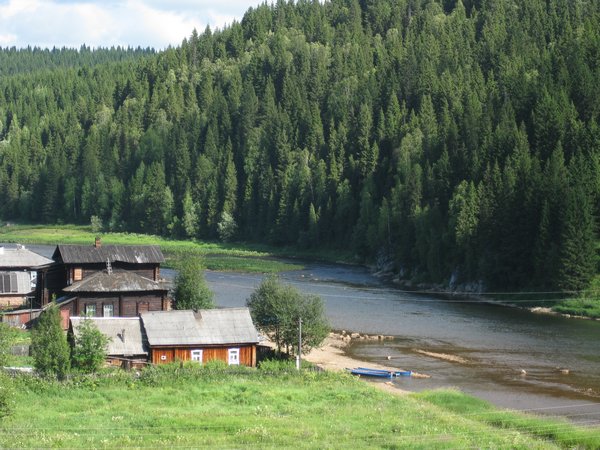The Urals
The Ural mountains, stretching from the Arctic Ocean in the North to Kazakhstan in the South, form the boundary between Europe and Asia, between European Russia and Siberia.
Many different indigenous groups live along the Urals’ immense length, on top of which there are hundreds of quaint rural villages such as the one in this photo nestling in their foothills. There are also some spectacular natural wonders, such as the 40m stone pillars of Mann Pupu Nyor in the Komi Republic rising inexplicably out of the grassy ground, the even larger Devil’s Finger near the village of Usva (accessible by many daily 3.5 hour buses from the city of Perm) and Stone City, an area covered in vast, almost mountain-like boulders 6km on foot from Usva. To find either Stone City or Devil’s Finger, both of which are quite a walk from the road, you will need to ask locals for directions. You could also get a taxi almost all the way to Stone City then walk the last 1.5km.
To get to Mann Pupu Nyor fly to Syktyvkar or take the train to Mikun. From Syktyvkar a train runs via Mikun to Troitsko-Pechorsk. It’s then a 2-day boat ride to Ust-Lyaga followed by a 38-kilometre walk to Mann Pupu Nyor. So not easy to reach but spectacular once you’re there!
The most northern part of the Urals, known as the Polar Urals, are located in the Yamal-Nenets Autonomous Region . Note: this is not the same as the Yamal Peninsula. The Yamal Peninsula and the Polar Ural Mountains are two separate districts of the Yamal-Nenets Autonomous Region, officially named Yamal District and Priural District respectively. In the Polar Urals you can find nomadic reindeer herders of the Nenets, Khanty and Komi indigenous peoples who live in chums (reindeer fur tepees), dress in traditional fur clothing and migrate hundreds of kilometres each year. To an outside eye they look almost the same as the Nenets who migrate on the Yamal Peninsula itself. However, as the Yamal Peninsula is further north and more isolated, the Nenets there have less contact with Russians and have preserved many aspects of their culture better than the nomads in the Polar Urals.
Click here for my blog about Perm, Usva, Devil’s Finger and Stone City. It’s 817 words and 21 photos.
Click here for my blog about a Russian banya experience in a small village in the Urals. It’s 977 words and 15 photos.

Leave a Reply